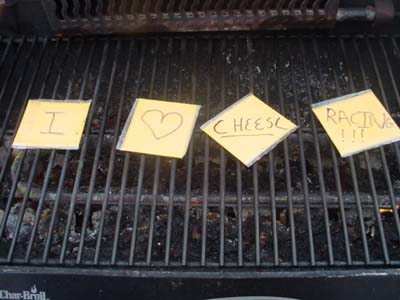A Brief History of Cheeseracing
Since the dawn of time (or the mid-morning of time at the very least) man has been assaulting milk-bearing creatures, large and small, to obtain their delicious milk.
Many aeons of time passed before a Neanderthal cave-dweller accidentally left a jug of milk at the cave entrance overnight, returning the next morning to find the jug filled with an evil-smelling curd-like substance of a dubious yellow colour.
Greatly excited by this discovery, the simple troglodytes experimented with a variety of cheese-making techniques until they had created the wide and varied range of evil-smelling curd-like substances (in a variety of dubious colours) that we know and love today.


This was not the end of the story, however. Advances in food-preserving technology brought more and more ingenious methods of cheese storage, until in 1965 Kraft patented the Single, an individually wrapped cheese slice. This was the culmination of years of research and development to find a suitable covering material and the optimum cheese recipe. It was discovered that by taking standard cheese, adding carefully calibrated amounts of rubber, and boiling the resulting mixture at 432 degrees centegrade for a week**, cheese of a suitable consistency and resilience could be made.
It was 1997 before the next great leap forward was made. Four friends had gathered in a quiet campsite near Osmington in Dorset. After an evening barbecue, their finely-honed analytical minds fortified by a combination of partially-cooked sausages, Stella Artois lager and Cockburn's Special Reserve Port (and several 'home made' cigarettes) an idea was hatched, as momentous in its own way as the ideas of Newton and Einstein.


The Idea
What would happen if a processed cheese slice was thrown onto a (still red-hot and glowing) barbecue?
Would the plastic covering melt and a noxious mixture of molten plastic and cheese descend onto the glowing coals below? Would the whole affair catch fire and squirt flaming cheese into the faces of the onlookers, scarring them hideously?
Such theories had reckoned without the ingenuity of the Kraft scientists, however, who had developed a plastic covering which, while fragile enough to be torn open by a small child, was fully compliant with UN Security Council Cheese Directive 4019/B which specifies that plastic cheese coverings must be heat resistant enough to withstand being dropped in boiling water, accidentally pressed with a steam iron, or strapped to the prow of a spaceship and flown directly into the sun.


The relatively meagre heat given out by a disposable barbecue, therefore, was no match for such a material. The cheese within the plastic, however, was heated sufficiently not only to melt, but to come to a furious boil.
Not only this, but the tiny amounts of air trapped within the cheese expanded, inflating the parcel.
An awe-struck silence (broken only by occasional belching) fell upon the stunned onlookers.
At this point the second momentous idea of the evening was hatched. Why not throw four slices on (one per participant) and see which of the four reached a fully inflated and boiling state first?
The sport of Cheeseracing was born!
